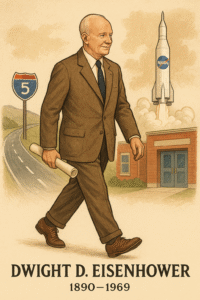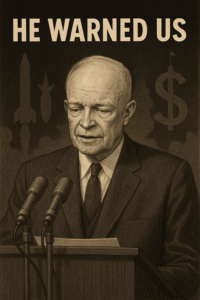President Dwight D. Eisenhower – General of the Army
On
- Real Men

/
RSS Feed
“The Commander Who Warned Us All”
Dwight D. Eisenhower wasn’t just a five-star general and two-term president—he was a builder, a unifier, and in the end, a truth-teller.
The Presidency (1953–1961): Steady Hands in Unsteady Times
As the 34th President of the United States, Eisenhower brought calm leadership to a nation caught between Cold War anxiety and rapid post-war change.
Built to Last: His Federal-Aid Highway Act of 1956 created the 41,000-mile Interstate Highway System—transforming commerce, defense, and daily life for generations.
Civil Rights Action: Though cautious by modern standards, he signed the Civil Rights Act of 1957, the first since Reconstruction, and sent federal troops to Little Rock to enforce desegregation—putting law above politics.
Space Age Vision: In response to Sputnik, he created NASA in 1958, launching America into the Space Race and sparking a new era of scientific achievement.

Peace Through Strength: He ended the Korean War and adopted the “New Look” defense strategy—emphasizing deterrence, not escalation. Yet, in his farewell address, he warned Americans of a new danger: the growing influence of the “military-industrial complex.”
“Only an alert and knowledgeable citizenry can compel the proper meshing of the huge industrial and military machinery of defense with our peaceful methods and goals.”
— Eisenhower, 1961

After the White House: Still Serving
Eisenhower didn’t disappear when his presidency ended—he just kept serving.
A President’s President: From his Gettysburg farm, he advised both Kennedy and Johnson, offering counsel on crises like the Bay of Pigs and Vietnam.
A Thoughtful Legacy: He authored two presidential memoirs and a personal reflection, At Ease, sharing wisdom without self-glorification.
Still a General: In a rare honor, President Kennedy restored his five-star rank after he left office—an acknowledgment that some titles transcend politics.
He Could Have Led Forever—But He Chose to Warn Us Instead
Eisenhower was a man who won wars but didn’t glorify them, built systems without seeking credit, and spoke hard truths when silence would’ve been safer.
He left us highways, a space agency, and a cautionary note we still haven’t fully heeded.
He didn’t rage or rant.
He didn’t sell hats.
He just served.
That’s what real leadership looks like.
During World War II, Dwight D. Eisenhower held several key command positions, culminating in the highest-ranking and most influential role in the Allied war effort in Europe, His rank and titles evolved as his responsibilities grew throughout the conflict.
At the time of the United States’ entry into the war in December 1941, Eisenhower was a Colonel. However, his rise through the ranks was swift. His most notable ranks and titles during World War II were:
General of the Army: This five-star rank was conferred upon Eisenhower in December 1944, making him one of a select few to hold this distinction in American history. It signified his immense authority and contribution to the war effort.
Supreme Commander, Allied Expeditionary Force (SCAEF): This was Eisenhower’s most famous and consequential title, which he held from late 1943 until the end of the war in Europe. In this capacity, he was the supreme commander of all Allied forces in the European Theater of Operations. He was responsible for planning and executing Operation Overlord, the Allied invasion of Normandy on D-Day, June 6, 1944, and the subsequent campaign to defeat Nazi Germany.
Prior to his appointment as SCAEF, Eisenhower also held other significant commands, including:
Commanding General, European Theater of Operations, U.S. Army (ETOUSA)
Allied Commander-in-Chief of the North African Theater of Operations
In essence, Dwight D. Eisenhower’s ultimate rank during World War II was General of the Army, and his most critical title was Supreme Commander, Allied Expeditionary Force.

